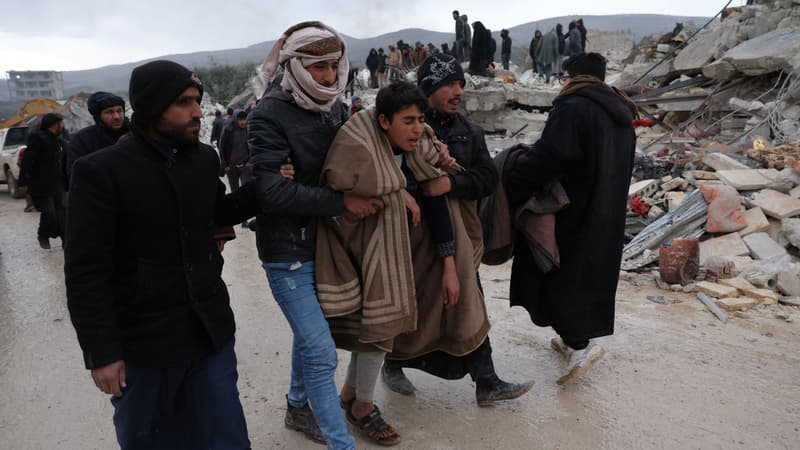A succession of earthquakes has devastated the Anatolian plateau since Monday. A terrible series, perceptible throughout the region, which has brought mourning to both Turkey and Syria and which promises to increase an already particularly high number of victims. For Adelheid Marschang, a World Health Organization official who spoke Tuesday on the sidelines of a meeting of the organization’s executive council, in the long term “23 million people” could be “exposed” as a result of the disaster.
As for the death toll, it already exceeds 5,000 victims, Turkey and Syria together. A statistic still far from its ceiling. As of Monday, the WHO raised the possibility of a balance close to 20,000 deaths. According to Catherine Smallwood, head of emergencies at the WHO’s European office, “there is the continuing possibility of further collapses and often we see numbers eight times higher than the initial numbers.”
How to explain such a recession and such devastation among populations? The reason lies in a combination of geological and physical factors.
unusual violence
The first reason for the explanation, the most obvious, is, of course, the power of the shock. The magnitude of the initial earthquake was thus assessed at 7.8. Worse still, it happened relatively close to the surface. David Rothery, a British geoscientist, explained to Reuters that “the earthquake on the surface will have been more severe than an earthquake of the same magnitude occurring at greater depths.”
Also, the initial quake was later repeated in multiple aftershocks. At least one of which turned out to be almost as violent, with a magnitude of 7.5.
An unusual phenomenon according to the seismologist Martin Vallée, from the Institute of Earth Physics in Paris.
“It happens very rarely in this context where the earthquake itself was already very strong. One would have thought that this earthquake due to its magnitude releases all the tensions accumulated in the earth and released by this earthquake,” he told BFMTV on Monday.
If the specialist admitted that it was not “necessarily surprising” to see several “small magnitude” earthquakes linked together, he continued: “But two earthquakes in Turkey of magnitude greater than 7.5 within a few hours of each other is something that nobody expected.”
Exhausting aftershocks around a fault
The consequences of these additional tremors are all the more devastating since, by definition, they are relentless in an already depleted territory, and especially in a badly damaged building.
Jessica Turner, a geologist with the US Geological Survey, noted the site The hill“Each aftershock shakes already unstable structures, causing even more damage.” The expert also pointed out that its effect was made even more devastating by the fact that these aftershocks come from various directions.
There are earthquakes, their aftershocks. And the characteristics of the place on which they weigh with all their weight: in this case the Anatolian fault. In seismology and geology, a “fault” specifically designates the meeting point of several tectonic plates. The Turkish-Syrian attacked zone faces three of them: the Anatolian, African and Arab plates. This plurality further increases the violence of the phenomenon.
Soil that liquefies?
There is an additional threat, the liquefaction of the soil. After such a shock, they can indeed lose their compactness.
“The earth does not actually become liquid, but it acts as if it were, and everything can flow much more easily”, developed the American scientist Jessica Turner, always with The hill.
In other words, homes and buildings, tested beforehand and now placed on suddenly and dangerously soft ground, risk collapsing more easily.
Population density at the center of the drama
In establishing the origins of such a terrible count, we must also consider more human data. The thorny question arises with every such disaster.
In a famous historical example, the philosopher Jean-Jacques Rousseau had thus derived the lethality of the 1755 Lisbon earthquake – which killed some 50,000 people according to a balance that will remain uncertain – from the excessively strict urban planning of the Portuguese capital, against his contemporaries who are content with metaphysical reflections.
However, this earthquake-affected part of Anatolia is densely populated. Kahramanmaraş, the epicenter of the earthquake, has more than a million inhabitants. Hatay province, further south, has a population density of 294 people per square kilometer.
unforgiving weather
Finally, in the conjunction of natural hazards and human vulnerability, the breadth of the Turkish-Syrian disaster is reinforced by the climatic conditions currently plaguing the plateau. Temperatures close to zero, even negative, snowfall, oppress the victims, chill the survivors, make it difficult for rescuers to work. They threaten to lengthen the list of dead.
“The absolute priority is to try to recover the people who are under the rubble” but “the temperature conditions there are still not very good. We are in the middle of winter, it is a few degrees or even at night it is -2, -3, -4 degrees. It is something that is going to be extremely complicated, ”says Patrick Coulombel, co-founder of the Emergency Architects Foundation, on BFMTV.
The race against time that has begun, therefore, is already taking a desperate turn. And the WHO says it expects to see the number of human casualties rise over the course of a week just beginning.
Source: BFM TV


